Science Highlights, October 5, 2016
Awards and Recognition









- Stuart Maloy wins awards from American Nuclear Society
- Rangachary Mukundan given Outstanding Achievement Award
- Rod Borup and Yu Seung Kim receive DOE awards of merit for fuel cell efforts
- Gary Grider recognized with Lab’s 2015 Feynman Innovation Prize
- Albert, Cincio, Le, and Lu named Laboratory Distinguished Postdoctoral Fellows
Analytics, Intelligence and Technology
First detailed flyer morphology during operation of exploding foil initiators
Computer, Computational and Statistical Sciences
Direct numerical simulations of the shock-turbulence interaction
Intelligence and Space Research
ChemCam finds manganese oxides on Mars, Lab project investigates source
Materials Physics and Applications
Avoiding the hole-doped cuprate pseudogap regime via HgBa2CuO4+d measurements
Awards and Recognition
Stuart Maloy wins awards from American Nuclear Society
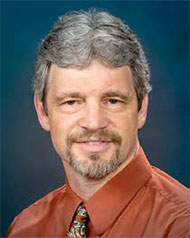
The American Nuclear Society (ANS) Materials Science and Technology Division (MSTD) has selected Stuart Maloy (Materials Science in Radiation and Dynamics Extremes, MST-8) for two awards: the Outstanding Achievement Award and the Literary Award.
The Outstanding Achievement Award honors those individuals who have made unique or sustained outstanding achievements in the field of materials science and technology contributing to the development of nuclear energy. The society cited him for “work on structural materials development and characterization of neutron-irradiated materials.”
Maloy earned a PhD in materials science from Case Western Reserve University and is a registered professional engineer in metallurgy. He joined the Lab 27 years ago. Maloy is the Advanced Reactor Core Materials technical leader for the Fuel Cycle Research and Development’s Advanced Fuels campaign at Los Alamos. He leads research on the development of advanced materials for core materials applications in fast reactors, such as the development of tempered martensitic steels and oxide dispersion strengthened steels. This work includes testing highly irradiated materials at the LANL CMR wing 9 hot cells and testing and development of advanced materials at the Materials Science Laboratory. In addition, Maloy is the Reactor Materials technical lead for the DOE-Office of Nuclear Energy (DOE-NE) programs, Nuclear Energy Enabling Technologies program. His position is part of the reactor materials crosscut effort supporting the development of revolutionary materials and providing broad-based, modern materials science benefiting DOE-NE objectives.
Stuart and his collaborators have won the Literary Award, which recognizes authors that have written the best full-length materials-oriented paper or review article in the field of materials science and technology contributing to the development of nuclear energy. The team performed tensile tests at LANL’s CMR hot cells on five 9-12% chromium (9-12Cr) tempered martensitic steels and one 14Cr oxide dispersion strengthened alloy, which had been side-by side irradiated in the Advanced Test Reactor at the Idaho National Laboratory. The particular heat of the 12Cr HT-9 tempered martensitic steel in this study has a much higher uniform elongation after irradiation than observed for earlier heats. (Heat in this context is the product of a single melting operation in a furnace.) This new heat of HT-9 has lower interstitial free nitrogen than previous heats. The authors noted that there is a general relation between lower interstitial solute contents and improved ductility and homogenous deformation in broadly similar steels. The Advanced Fuels Campaign of DOE’s Fuel Cycle Research and Development Program funded the LANL work, which supports the Lab’s Energy Security mission area and the Materials for the Future science pillar through the development of materials for nuclear energy.
Reference: “Characterization and Comparative Analysis of the Tensile Properties of Five Tempered Martensitic Steels and an Oxide Dispersion Strengthened Ferritic Alloy Irradiated at ≈295 °C to ≈6.5 dpa,” Journal of Nuclear Materials 468, 232 (2016); doi: 10.1016/j.jnucmat.2015.07.039. Authors: S.A. Maloy and O. Anderoglu (MST-8), T. A. Saleh (Nuclear Materials Science, MST-16), T. J. Romero (Inorganic Isotope and Actinide Chemistry, C-IIAC), G. R. Odette, T. Yamamoto, and S. Li (University of California – Santa Barbara); J. I. Cole and R. Fielding (Idaho National Laboratory).
The American Nuclear Society, an international organization with approximately 11,000 engineers, scientists, administrators, and educators, is dedicated to promoting awareness and understanding with regard to the application of nuclear science and technology. Technical contact: Stuart Maloy
Rangachary Mukundan given Outstanding Achievement Award
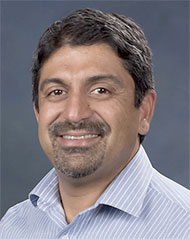
Rangachary Mukundan (Materials Synthesis and Integrated Devices, MPA-11) received the 2016 Sensor Division Outstanding Achievement Award, presented biennially by the Sensor Division of the Electrochemical Society (ECS). The award is the highest recognition the division can bestow on a member.
Los Alamos has performed pioneering research in understanding the working principles of mixed potential electrochemical sensor leading to patented novel sensor designs. Currently, the Lab is working to commercialize these sensors for hydrogen safety and automotive emissions control applications with industrial partners.
Mukundan (Mukund) earned a Ph.D. in materials science and engineering from the University of Pennsylvania. His thesis won the S. J. Stein Prize for superior achievement in the field of new or unique materials in electronics. He joined LANL in 1997 as a postdoctoral fellow and became a staff scientist in 1999. His research interests include electrochemical gas sensors, fuel cells, and energy storage devices. Mukundan leads several projects related to sensors and fuel cells, which the DOE funds. His work on sulfur tolerant anodes for fuel cells was recognized as Scientific American’s Top 50 Science and Technology Achievements for 2003. The J. B. Wagner Award of the High Temperature Materials Division of the Electrochemical Society also honored his work. Mukundan is the co-inventor on 6 U.S. patents and has authored more than 125 papers including more than 50 in peer-reviewed journals that have been cited over 4,000 times. He is the technical editor in the area of sensors and measurement sciences for ECS journals.
The Electrochemical Society is a U.S.-based professional association with more than 9,000 members in more than 75 countries. Its mission is to advance theory and practice at the forefront of electrochemical and solid-state science and technology, and allied subjects. Mukundan will receive the award at the 230th ECS Meeting in Honolulu in October. Technical contact: Rangachary Mukundan
Rod Borup and Yu Seung Kim receive DOE awards of merit for fuel cell efforts
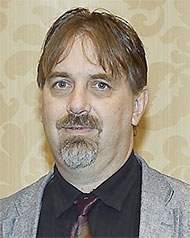
Rod Borup
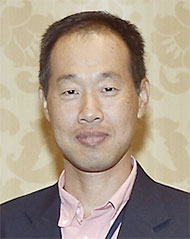
Yu Seung Kim
Members of Los Alamos’s fuel cells program were recently recognized with 2016 Annual Merit Review Awards, presented at the annual Merit Review and Peer Evaluation Meeting of the Department of Energy’s Hydrogen and Fuel Cells Program.
Rod Borup (Materials Synthesis and Integrated Devices, MPA-11) was recognized for his outstanding role as director of DOE’s Fuel Cell Consortium for Performance and Durability. He has been instrumental in forming and leading the core team of five national laboratories and in reaching out to industrial developers to accelerate improvements in polymer electrolyte membrane fuel cell (PEMFC) performance and durability. Borup is the program manager of the fuel cells group at LANL and has made extensive contributions to the fuel cell research community as a renowned expert in PEMFCs. He is a member of the U.S. DRIVE Fuel Cell Technical Team and a co-chair of the DOE’s Fuel Cell Technologies Office Durability Working Group. Borup won the 2015 Research Award presented annually by the Energy Technology Division of the Electrochemical Society for contributions to the fundamental understanding of the durability of polymer electrolyte fuel cells. He received a PhD in chemical engineering from the University of Washington. He joined Los Alamos in 1994 as a postdoctoral researcher in the Lab’s former Engineering Sciences and Applications Division, which had one of the nation’s first research groups studying fuel cell components.
Yu Seung Kim (MPA-11) and collaborator Cy Fujimoto (Sandia National Laboratories) were recognized for their outstanding technical contributions and achievements in the development of alkaline exchange membrane (AEM) fuel cell technology. As a result of their work, this nascent technology is beginning to show promise for low-cost fuel cells and electrolyzers. Their collaboration since 2009 demonstrates how technology can be more effectively advanced through inter-lab partnerships. These coprincipal investigators investigated the degradation mechanism of AEM materials and subsequently developed novel AEMs that have shown unprecedented alkaline stability. The resulting membranes and membrane electrode assemblies have demonstrated good performance and durability under both fuel cell and electrolysis operating conditions, opening opportunities in both fields.
The meeting, which was held in June in Washington, D.C., featured hydrogen and fuel cell projects funded by the DOE Office of Energy Efficiency and Renewable Energy and the Office of Science. The research supports the Lab’s Energy Security mission area and the Materials for the Future science pillar through the development of materials for clean energy. Technical contact: Rod Borup
Gary Grider recognized with Lab’s 2015 Feynman Innovation Prize
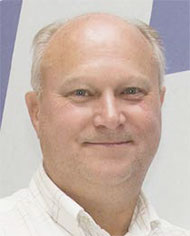
High Performance Computing (HPC) Division Leader Gary Grider received the 2015 Richard P. Feynman Innovation Prize. The award recognizes the contribution of an individual or team that has successfully deployed an idea through a partnership, resulting in a measurable return on investment in the Lab’s mission performance, positive effect on the U.S. economy, and broader public awareness of the Laboratory’s impact. Grider received the prize for his expertise and national leadership in developing cutting-edge HPC strategies and for his innovative business partnerships. He holds 12 patents and over 30 active patent applications in high performance computing.
Grider has a vast history of contributing key ideas in large-scale data storage. He is one of the principal leaders of a small multi-agency group of experts who advise the government in its Input/Output (I/O) related research investments and strategies. For example, he was a key intellectual contributor in the early days of both Lustre and Panasas, two of the three dominant parallel clustered file systems in the world today. Lustre alone comprises 60% of the HPC governmental and commercial storage markets.
In 2012, Grider received the Laboratory’s Distinguished Copyright award for his development and continued work on the Parallel Log-structured File System (PLFS). The system is a parallel IO abstraction layer that rearranges unstructured, concurrent writes by many clients into sequential writes to unique files (N-1 into N-N) to improve efficiency of the underlying parallel file system. It is the base technology used for new product development by Intel, EMC, Data Direct Networks (DDN), and is featured as a core technology in the DOE’s FastForward program, which is targeted at eliminating barriers on the path to exascale computing.
His leadership of the development of the Parallel Log-Structured File System (PLFS) and the concept of a Burst Buffer directly impacts the performance of the Trinity machine, NNSA’s premier supercomputer for modeling and simulation. Grider coined the term “burst buffer”. The burst buffer technology mitigates an I/O gap between high-speed interconnects and relatively slower file systems. PLFS and Burst Buffer concepts invented at Los Alamos are being deployed at many DOE extreme-scale computing sites within the next three years, as well as at large commercial HPC sites through products produced by Intel, Data Direct Networks, IBM and Cray. These concepts, which came directly from a Cooperative Research and Development Agreement (CRADA) with premier storage partner EMC Corp (EMC2), are considered base technologies that will eliminate barriers to exascale class computing. Many burst buffer solutions include PLFS-based software at their core.
Grider continues to lead several new efforts in the HPC field. For example, HPC Division is partnering via CRADA with Seagate to investigate power-managed disk and software solutions for deep data archiving. The new collaboration will allow the exploration of advanced data archiving methods at the mission-critical government level, which could influence big data in broader enterprise applications.
Another recent innovation is the design of the MarFS storage system. MarFS is the first of its kind to make cloud-style object storage usable by legacy HPC applications and users. It enables normal file system access with the file and folder concepts of data on scalable cloud storage systems. This concept is being implemented as campaign storage at LANL, a tens to hundreds of petabyte storage layer that sits between a parallel file system and a parallel archive. MarFS will directly benefit the efficiency of Trinity and has garnered interest from multiple corporate storage vendors.
Grider earned a B.S. in electrical engineering and an MBA with emphasis in Management Information Systems, Statistics, Physics, and Mathematics from Oklahoma State University. He joined the Lab as a contractor in 1989, and then became a LANL employee in 1999. Technical contact: Randal Rheinheimer
Albert, Cincio, Le, and Lu named Laboratory Distinguished Postdoctoral Fellows
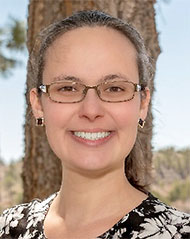
Andrea Albert, Marie Curie Distinguished Postdoctoral Fellow. This Fellowship, named after the distinguished nuclear scientist and only person honored with two Nobel Prizes in different scientific categories, recognizes, encourages, and rewards outstanding scientific and engineering contributions by women.
Albert (Neutron Science and Technology, P-23) earned a Ph.D. in physics from Ohio State University. She studies the fundamental forces and particles that govern the physical laws of the Universe. In the growing field of particle astrophysics, the entire Universe is a laboratory to examine particle interactions in extreme cosmic environments unobtainable in terrestrial labs. Her research focuses on detecting high-energy gamma rays produced in known non-thermal processes and new exotic mechanisms like particle dark matter interactions. Approximately 85% of the mass in the Universe is not the baryonic matter that is well described by the Standard Model of particle physics. Many theoretically- and observationally-motivated models predict that dark matter may be a particle that can annihilate or decay, producing detectable gamma rays. Albert and her mentor, Brenda Dingus (P-23), use the newly completed HAWC (High Altitude Water Cherenkov) Gamma-Ray Observatory to detect high-energy gamma rays. She also continues as a coordinator in the Fermi Gamma-Ray Space Telescope–Large Area Telescope Collaboration. Albert is passionate about science outreach and has shared her excitement for physics with many audiences from elementary school classrooms to public lectures to congressional offices.

Lukasz Cincio, J. Robert Oppenheimer Distinguished Postdoctoral Fellow. This Fellowship, named after the Lab’s first Director, recognizes individuals whose research aligns with LANL’s mission and who have demonstrated outstanding ability in research.
Cincio (Physics of Condensed Matter and Complex Systems, T-4 and Condensed Matter & Magnet Science, MPA-CMMS) earned a Ph.D. with distinction in physics/astronomy and applied computer science from the Jagiellonian University. His research at the interface between condensed matter physics and quantum information theory examines how local interactions between many particles lead to large scale, emergent phenomena. He studies topological order, a phenomenon in quantum physics. Topological order supports anyons - exotic particles that may become a core ingredient of a revolutionary topological quantum computer. Cincio develops numerical algorithms based on tensor networks, a breakthrough in computational quantum many-body physics. Wojciech Zurek (T-4) and Filip Ronning (MPA-CMMS) co-mentor him.
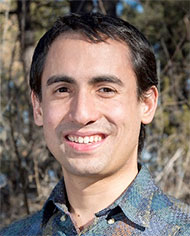
Ari Le, Feynman Distinguished Postdoctoral Fellow. This Fellowship, named after the famed theoretical physicist and winner of the 1965 Nobel Prize in Physics, recognizes individuals whose research is in theory or computing and who have demonstrated outstanding ability in research.
Le (Plasma Theory and Applications, XCP-6) earned a Ph.D. in physics from the Massachusetts Institute of Technology. He studies plasma kinetic effects, processes that occur on small scales outside the scope of typical fluid models. His computational work has applications to space plasmas and laboratory experiments, including those on inertial confinement fusion. His research interests include kinetic simulations, magnetic reconnection, inertial fusion, and plasma shocks and turbulence. Bill Daughton, Andrei Simakov, and Tom Kwan (XCP-6) co-mentor him. He joined LANL in 2015 as a Director’s Postdoctoral Fellow prior to receiving the Feynman Fellowship.
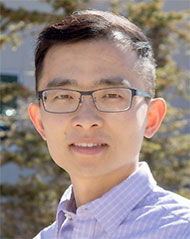
Xujie Lu, J. Robert Oppenheimer Distinguished Postdoctoral Fellow. Lu (Earth System Observations, EES-14 and the Center for Integrated Nanotechnologies, MPA-CINT) earned a Ph.D. in materials physics and chemistry from the Shanghai Institute of Ceramics, Chinese Academy of Sciences. Xujie has expertise in interdisciplinary fields including energy materials/devices, high pressure/temperature techniques, synchrotron characterization and film deposition. His LANL research project develops highly conducting oxides with extraordinary electronic properties by combining high-pressure techniques and thin-film deposition methods, for environmental and energy-related applications. Hongwu Xu (EES-14) and Quanxi Jia (MPA-CINT) mentor him. Lu received the Excellent PhD Thesis Award, the prestigious President Award of the Chinese Academy of Sciences, and a DOW Chemical Scholarship. He joined LANL as a Postdoctoral Research Associate in 2015.
A complete list of past and present Laboratory Distinguished Postdoctoral Fellows is here.
The deadline for submitting 2017 candidate packages to the Postdoc Program Office is November 1. More information about the Lab’s Postdoctoral Program is in a Los Alamos brochure here (pdf). Technical contact: Mary Anne With
Analytics, Intelligence and Technology
First detailed flyer morphology during operation of exploding foil initiators
Exploding foil initiators (EFIs), also known as slapper initiators or detonators, offer safety and timing advantages over other means of initiating high explosives. However, imaging and reconstructing these detonators in action is problematic. A new capability, developed by researchers from Los Alamos and Lawrence Livermore national laboratories and National Security Technologies combines state-of-the-art imaging capabilities with recent applications of computed tomographic reconstruction algorithms to acquire x-ray images and generate 3-D snapshots of EFI morphology during operation. The Journal of Applied Physics published the results, which provide the first detailed flyer morphology during EFI operation. (See the 3-D movie of the exploding foil initiator here.)
EFIs consist of a thin conductive foil that is heated and vaporized by a high-voltage, high amperage electric current. This vaporizing metal accelerates a thin plastic flyer to several km/s across a small (approximately 100 μm) gap. This flyer then strikes and shock initiates an explosive. EFIs offer enhanced safety for two reasons: 1) less-sensitive high explosives are directly initiated, eliminating the need for highly sensitive and more dangerous primary explosives, and 2) the initiator and associated electrical hazards are not in direct contact with the explosive prior to detonation. The EFIs also confer precise timing relative to conventional fusing options. In previous EFI studies the small length scales coupled with km/s velocities have restricted high fidelity direct experimental measurement of fundamental properties such as the actual shape of the plastic flyer, nature of the metal plasma, and electrical contact performance.
The four-camera system from LANL’s IMPULSE multi-frame X-ray Phase Contrast Imaging detector system currently located at Argonne National Laboratory’s Advanced Photon Source acquired four - eight images from successive x-ray pulses from each shot. The team imaged the EFI metal plasma and plastic flyer traveling at 2.5 km/s with 80 ps pulses spaced 153.4 ns apart. Multiple acquisitions at different incident angles and advanced computed tomography reconstruction algorithms produced a 3-D image of the flyer.
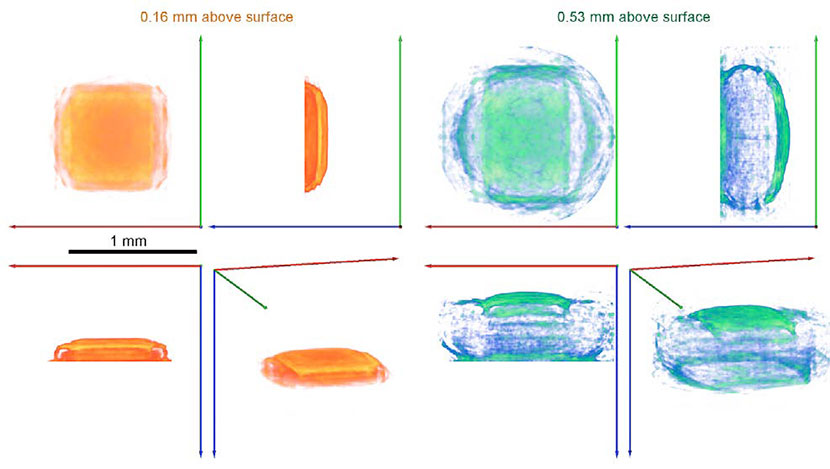
Figure 10. 3-D images of in‐flight slappers reconstructed by the new software package Livermore Tomography Tools. Reconstruction used images obtained from 7 different experiments (each with a different initial orientation relative to the incident x-ray beam) to create a 3-‐D view. The slapper travelled at ~ 2.5 km/s in each view. The x, y, and z axes are designated red, green, and blue, respectively. The orange plots (left) are multiple views of the reconstruction at a flight distance of 0.16 mm (early time picture); the right plots show reconstruction at a flight distance of 0.53 mm (later time). The two together show the 3-D evolution of the flyer after launch.

Figure 11. An image from the movie, which renders the 3-D flyers at approximately 0.16 mm above the surface and approximately 0.53 mm above the surface.
The x-ray images and the 3- D reconstruction both show a strong anisotropy in the shape of the flyer and underlying foil parallel vs. perpendicular to the initiating current and electrical contacts. These results provide detailed flyer morphology during the operation of the EFI. Flyer shape, curvature, copper plasma, flyer break-up, and elongation have all been measured with ultra-fast x-ray radiographs and the corresponding 3-D reconstruction.
The rich imaging data on EFI and flyer microstructure with time represent a new opportunity to refine understanding of flyer morphology during operation of slapper initiators. Parameters can be verifiably tuned to achieve optimal performance in EFI initiators. The data will aid in understanding the initiation mechanism for slapper detonators, which is important for assessing aging margins, safety, and performance, and developing new and improved designs for the NNSA Life Extension Programs (LEPs).
The experiment is an example of science on the roadmap to MaRIE, LANL’s proposed experimental facility for studying matter-radiation interactions in extremes. Using MaRIE’s combination of a unique hard x-ray free electron laser and in situ characterization tools, researchers would be able to take this research further with improved time and spatial resolution to capture the early dynamics of these systems, increased x-ray intensities, and higher energies needed to image through complete initiator/detonator systems.
Reference: “X-ray Imaging and 3D Reconstruction of in-flight Exploding Foil Initiator Flyers,” Journal of Applied Physics 119, 235901 (2016); doi: 10.1063/1.4953681. Authors: T. M. Willey, K. Champley, R. Hodgin, L. Lauderbach, M. Bagge-Hansen, C. May, T. van Buuren (Lawrence Livermore National Laboratory); N. Sanchez (Detonator Technology, Q-6); B. J. Jensen (Shock and Detonation Physics, M-9); and A. Iverson (National Security Technologies). NNSA Campaign 2 and the DOE/DoD Joint Munitions Program funded the research, which supports the Lab’s Nuclear Deterrence and Global Security mission areas and the Materials for the Future and Science of Signatures science pillars. Technical contact: Brian J. Jensen
Chemistry
Effect of functional groups in bioderived fuel candidates
Lab researchers aim to turn biomass into fuels. Biomass represents a viable source of renewable carbon with which to replace fossil-based components in transportation fuels. Chemists think in terms of functional groups while fuel engineers think in terms of physical fuel properties. In an article published in the journal ChemSusChem and featured on the back cover, the authors relate these two different ways of thinking about fuels. They present concepts that provide a basis to design and synthesize molecules from biomass that could provide useful transportation fuels.
To increase the volumes of bioderived components in current fuels or to develop a new fully bio-derived fuel, the physical properties of the fuel must match as closely as possible to the physical properties outlined in international standards for fuels. This enables compatibility with current fuel and engine infrastructure. These properties are closely linked to molecular structure, which affects the combustion characteristics of a particular fuel or fuel blend. Retaining the same overall performance and characteristics of currently used fuels is essential. Gasoline and diesel internal combustion engines also use different fuels with different physical properties. Gasoline is volatile, has a low flash point (-43 °C), and requires igniting via a spark in spark ignition engines as a gasoline/air mixture. Diesel is less volatile, comprised of heavier hydrocarbons than gasoline and ignites at high temperatures achieved under high compression in compression ignition engines.
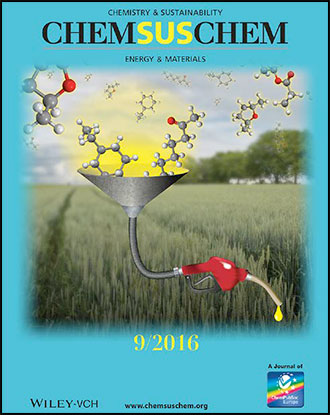
Figure 1. The journal’s back cover depicts the concept of linking bioderived molecules and the functional groups contained within these molecules for transportation fuel. This article discusses the important traits that are required in a transportation fuel and examines the effect that carbon and oxygen groups have on these properties. Graphic credit: Josh Smith, Chemistry Division
A common aim for biofuel development is the complete defunctionalization of these bioderived molecules to produce alkanes consisting solely of hydrogen and carbon atoms. In contrast, the Los Alamos team focuses on producing any hydrocarbon (including oxygenated hydrocarbons) as a “drop-in” replacement for petroleum fuels. This strategy may also remove costly processing steps that do not positively impact the fuel characteristics, improve the economics of a process, and provide a reduction in greenhouse gas (GHG) emissions.
Fuel properties can be altered by changing the carbon chain length, the degree of saturation, cyclization, aromatization, isomerization, or by introducing oxygen-containing functional groups. Increasing the carbon chain length of linear alkanes increases the boiling point, melting point, and viscosity. Alkanes of 9 to 11 carbon atoms can be considered for gasoline applications, and 12 to 16 carbon alkanes can be considered for diesel applications, though none can be considered as perfect for either application. The amount of bio-derived fuel that can be blended without detrimental effects on performance can be increased by closely matching the properties to the existing fuel or determining the combined properties of the resultant fuel blend. Consideration of the multiple aspects of chain length, oxygen content, and functional group position as outlined in this article should allow for a greater set of resources with respect to molecules that are more likely to be fuel candidates. However, fuel property testing is ultimately necessary to fully determine the fuel characteristics as single components and as blends.
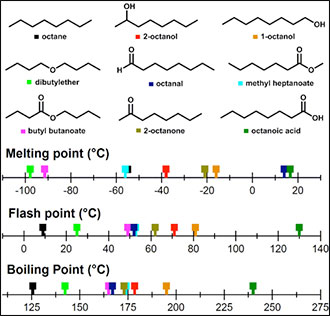
Figure 2. Effect of oxygen functional groups on melting, flash, and boiling points of eight-carbon species.
Reference: “The Effect of Functional Groups in Bio-Derived Fuel Candidates,” ChemSusChem 9, 922 (2016); doi: 10.1002/cssc.201600159. Authors: Andrew D. Sutton (Principle Investigator, Inorganic, Isotope, and Actinide Chemistry, C-IIAC), Rhodri W. Jenkins, Cameron M. Moore, and John C. Gordon (C-IIAC); Troy A. Semelsberger (Materials Synthesis and Integrated Devices, MPA-11); and Christopher J. Chuck (University of Bath, UK).
LANL researchers who are engaged in projects sponsored by the DOE Office of Energy Efficiency & Renewable Energy (EERE) Bioenergy Technologies Office or the Laboratory Directed Research and Development (LDRD program) wrote the article. The work supports the Lab’s Energy Security mission area and the Materials for the Future science pillar through the development of biofuels for energy. Technical contact: Andrew Sutton
Computer, Computational and Statistical Sciences
Direct numerical simulations of the shock-turbulence interaction
The interaction of shock waves with turbulence is an important aspect in many types of flows, e .g ., hypersonic flight, supersonic combustion, astrophysics, and Inertial Confinement Fusion (ICF). The Fluid Dynamics team in Computational Physics and Methods (CCS-2) has performed some of the largest direct numerical simulations of fluid turbulence in the world. The simulations support DOE programs, including NNSA Defense Science and Advanced Simulation and Computing (ASC). The simulations provide accurate hydrodynamics simulations on advanced architectures and support future missions and capabilities for the national security mission.
Turbulence theory and the subsequent model development rely on experiments or high resolution direct numerical simulations (DNS) data for development, verification, and validation. DNS is a powerful research tool to study the physics of turbulence, verify, and improve models, and help guide and design better experiments. The DNS technique seeks accurate solutions to the governing equations, so that all relevant scales are accurately resolved, using numerical simulations based on high-order accurate discretization algorithms. DNS rely on non-dissipative high accuracy schemes and are conducted without resort to subgrid modeling or the introduction of artificial numerical dissipation. Computations allow a degree of control in isolating specific physical phenomena that are typically inaccessible in experiments. Advances in supercomputing technology and algorithms enable simulations of simple flows at ranges of scales comparable to or even larger than in laboratory experiments. Petascale computing could further increase the range of scales of the simulations and enable accurate calculations of more complex flows.
The interaction of a shock wave with turbulence represents a basic problem to study some of the phenomena associated with high speed flows. This problem is very computationally challenging due to the large range of scales involved. Daniel Livescu and Jaiyoung Ryu (CCS-2) showed that when there is a large scale separation between turbulence scales and the shock width, and the upstream turbulence is weak, the interaction could be described by the Linear Interaction Approximation (LIA). The results reconcile a longstanding open question about the role of the LIA theory and establish LIA as a reliable prediction tool to investigate shock-turbulence interactions. The team used this approach to investigate the dependence of post-shock turbulence on the shock Mach number and Reynolds numbers outside the reach of laboratory experiments. The team extended the classical LIA formulas to be able to generate full 3-D fields. The researchers used this procedure to show profound changes in the structure of post-shock turbulence, with significant potential implications on turbulence modeling.
In general, the shock interaction significantly changes the properties of upstream turbulence. The thermodynamic quantities are also strongly affected by the interaction with the shock. Both acoustic and entropic components are generated even for upstream turbulent vortices. These components propagate with different velocities. The specific correlations between the thermodynamic quantities and the orientations of their gradients depend on the relative strength of these components. Researchers expect that these structural changes in post-shock turbulence will have a significant effect on the evolution of the flow pattern away from the shock.
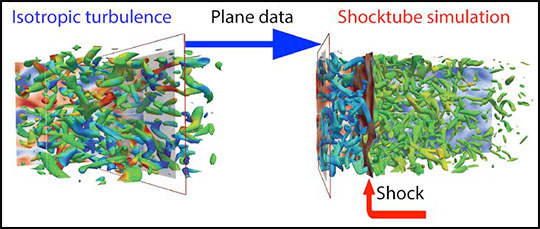
Figure 3. Data generated in separate isotropic turbulence simulations are fed through the inlet of a shock tube with a stationary shock inside.
Researchers have used the results to calibrate the BHR turbulence model at Mach numbers outside the reach of typical laboratory experiments. The team developed a two-length scale turbulence model to capture a wide variety of single-phase flows, from incompressible flows with single fluids, to mixtures of different density fluids (variable density flows), to flows over shock waves. The model focuses on separating the decay and transport length scales, because the two physical processes are generally different in inhomogeneous turbulence. This new model is a first step towards bridging the gap between homogenous and inhomogeneous flows.
References:
“Turbulence Structure behind the Shock in Canonical Shock-vortical Turbulence Interaction,” Journal of Fluid Mechanics 756, R1 (2014); doi: 10.1017/jfm.2014.477. Authors: Jaiyoung Ryu (formerly CCS-2, currently University of California–Berkeley) and Daniel Livescu (CCS-2).
“Vorticity Dynamics after the Shock-turbulence Interaction,” Shock Waves 26, 241 (2016); doi: 10.1007/s00193-015-0580-5. Authors: D. Livescu (CCS-2) and J. Ryu (University of California– Berkeley).
“A Two Length-Scale Turbulence Model for Single-Phase Multi-Fluid Mixing,” Flow Turbulence Combustion 96, 1 (2016); doi: 10.1007/s10494-015-9643-z. Authors: J. D. Schwarzkopf and R. A. Gore (XTD Integrated Design & Assessment, XTD-IDA), D. Livescu and J. R. Baltzer (CCS-2), and J. R. Ristorcelli (Methods And Algorithms, XCP-4). NNSA Science Campaign 4 funded the research, which supports the Lab’s Nuclear Deterrence mission area and the Nuclear and Particle Futures science pillar. The LANL Institutional Computing (IC) Program and the Sequoia Capability Computing Campaign at Lawrence Livermore National Laboratory provided computational resources for the work. Technical contact: Daniel Livescu
Intelligence and Space Research
ChemCam finds manganese oxides on Mars, Lab project investigates source

Figure 4. The Curiosity rover examines the Dillinger member of the Kimberley formation in Gale crater, Mars, where high manganese minerals were discovered. Image credit: MSSS/JPL/NASA and AGU/GRL/Wiley.
The discovery of manganese oxides in Martian rocks suggests that the Mars was once more Earthlike than previously believed. A paper in Geophysical Research Letters led by Nina Lanza (Space and Remote Sensing, ISR-2) reveals that NASA’s Curiosity rover observed high levels of manganese oxides in Martian rocks, which could indicate that higher levels of atmospheric oxygen once existed on our neighboring planet. The journal featured the research on its cover.
Manganese oxides require abundant liquid water and strongly oxidizing conditions to form. In the Earth’s geological record, the appearance of high concentrations of manganese is an important marker of a major shift in our atmosphere’s composition, from relatively low oxygen abundances to the oxygen-rich atmosphere we see today. More than three billion years ago, Earth had abundant water but no widespread deposits of manganese oxides until after photosynthesizing microbes raised the oxygen levels in the atmosphere, transforming Earth’s environment. The chemistry of rocks of that age all over the world record this monumental environmental change.
The discovery of high-manganese materials on Mars suggests that similar atmospheric conditions were present there, although the source of oxygen (and where it went) remain unknown. Today’s Martian atmosphere contains very little free oxygen, and current conditions do not allow manganese oxides to form. Researchers found the high-manganese materials in mineral-filled cracks in sandstones in the Kimberley region of Gale crater, which the Curiosity rover has been exploring for the last four years. Because manganese oxides require strong oxidants and sufficient liquid water at typically higher pH ranges to form, their presence suggests that the fracture network hosted strongly oxidizing groundwaters at some time in the past. The authors infer that manganese was likely concentrated prior to being transported in subsurface fluids, rather than being derived locally from in situ rock weathering. The Opportunity rover, which has been exploring a different part of Mars since 2004, also recently discovered high-manganese deposits in its landing site thousands of miles from Curiosity. These results support the idea that the conditions needed to form these materials were present well beyond the Gale crater.
The Los Alamos-developed ChemCam instrument, led by Roger Wiens (ISR-2), made the primary measurements of the high-manganese materials. ChemCam uses laser-induced breakdown spectroscopy (LIBS) to vaporize samples of rocks on Mars and analyze their chemical compositions. This work stems from the Lab’s experience building and operating more than 500 spacecraft instruments for national defense. LANL is building a new instrument, called SuperCam, which will use a laser to measure both chemistry and mineralogy directly. SuperCam will be placed aboard the Mars 2020 rover.
Reference: “Oxidation of Manganese in an Ancient Aquifer, Kimberley Formation, Gale Crater, Mars,” Geophysical Research Letters 43, 7398 (2016); doi: 0.1002/2016GL069109. Authors: Nina L. Lanza, Roger C. Wiens, and Ann M. Ollila (ISR-2); Samuel M. Clegg (Physical Chemistry and Applied Spectroscopy, C-PCS); and collaborators from Washington University, Space Science Institute, California Institute of Technology, University of Guelph, Stony Brook University, NASA Johnson Space Center, Western Washington University, Arizona State University, University of Western Ontario, Jet Propulsion Laboratory, Johns Hopkins University, Institut de Recherche en Astrophysique et Planétologie, Malin Space Science Systems, Université de Lorraine, Oregon State University, University of Copenhagen, U.S. Naval Academy, Université de Nantes, Luleå University of Technology, Instituto Andaluz de Ciencias de la Tierra, Purdue University, University of New Mexico, Muséum d’Histoire Naturelle, University of New Brunswick, Lunar and Planetary Institute, Planetary Science Institute, and Centro de Astrobiologia.
Now that researchers have discovered manganese oxides on Mars, the next step is to determine their origins. The team cannot conduct the study using ChemCam because they do not know if the manganese minerals they have observed there are biogenic (caused by life processes) or not. However, scientists can perform work at Los Alamos with the ChemCam engineering model. Lanza leads a Laboratory Directed Research and Development (LDRD) program Early Career Award to investigate the chemical and mineralogical signatures of non-biogenic versus biogenic manganese, which is directly produced by microbes. Using the same instruments as the current and upcoming rovers, Lanza is investigating chemical or mineralogical signatures to distinguish between manganese oxides produced by life and those produced in a non-biological setting. This knowledge could be directly applied to observations from Mars from both ChemCam and the upcoming SuperCam to better understand how manganese oxides might have formed on Mars.
NASA funded the research, which supports the Lab’s Global Security mission area and the Science of Signatures science pillar through development of techniques for rapid chemical analyses in extreme environments and remote sensing for space situational awareness. Technical contact: Nina Lanza
Materials Physics and Applications
Avoiding the hole-doped cuprate pseudogap regime via HgBa2CuO4+d measurements
The observation of a reconstructed Fermi surface via quantum oscillations in hole-doped cuprates has opened a path towards identifying broken symmetry states in the pseudogap regime. However, the identification has remained inconclusive due to the multi-frequency quantum oscillation spectra and complications accounting for bilayer effects in most studies. A team, including researchers from the Laboratory’s National High Magnetic Field Laboratory-Pulsed Field Facility (NHMFL-PFF), overcame those impediments with high-resolution measurements on the structurally simpler cuprate HgBa2CuO4+δ (Hg1201), which features one CuO2 plane per unit cell. Nature Communications published the findings.
Identifying broken symmetry states, particularly in the pseudogap region, is essential for understanding the cuprate phase diagram. Advances in crystal quality and measurement sensitivity, plus access to the 100T multi-shot magnet at LANL’s NHMFL-PFF, enabled the researchers to measure high-resolution quantum oscillations in Hg1201.
The researchers observed a single oscillatory component with no signatures of magnetic breakdown tunneling to additional orbits. They concluded that the Fermi surface comprises a single quasi-two-dimensional pocket. Quantitative modeling of these results indicates that 1) a biaxial charge density wave within each CuO2 plane leads to the reconstruction and 2) rules out crisscrossed charge stripes between layers as a viable alternative in Hg1201. The authors determined that the characteristic gap between reconstructed pockets is a significant fraction of the pseudogap energy.
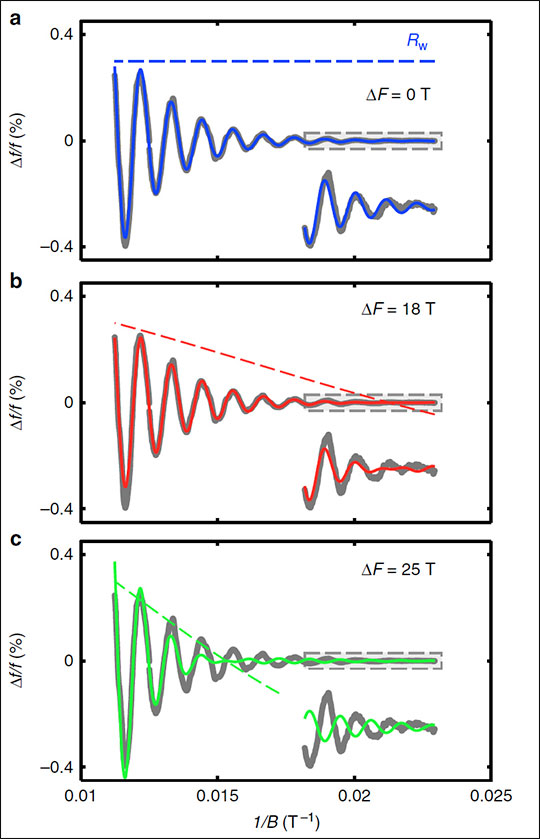
Figure 5. The effect of 2-‐D Fermi surface warping on quantum oscillations on Hg1201. Graphs b and c display a higher degree of warping.
The researchers concluded that ultra-high magnetic field study of Hg1201 presents a promising path toward resolving the many outstanding conundrums in an understanding of high temperature superconductivity in the cuprates. Finding a single section of Fermi surface provides some insight into the superconducting mechanism. Scientists observe the highest temperature superconductors in what appears to be the vicinity of a low temperature phase transition. However, superconductivity masks the nature of the phase transition, specifically the associated broken symmetry. The symmetry and number of Fermi surface sections directly reflect this and greatly constrain the theoretical description of cuprate superconductors.
More information about mechanisms of high temperature superconductivity is needed to enable design of new materials with operating temperatures approaching room temperature or with other desirable properties such as reduced electrical distribution loss or being ductile enough to be readily formed into conductors. Development of lossless power transmission is important because approximately 6% of electricity currently generated in the United States is lost during distribution.
Reference: “Single Reconstructed Fermi Surface Pocket in an Underdoped Single-layer Cuprate Superconductor,” Nature Communications 7, 12244 (2016); doi: 10.1038/ncomms12244. Authors: M. K. Chan (Condensed Matter and Magnet Science, MPA-CMMS, and University of Minnesota), N. Harrison, R. D. McDonald, B. J. Ramshaw and K. A. Modic (MPA-CMMS); N. Barisic (University of Minnesota and Technishce Universitat Wein, Austria); and M. Greven (University of Minnesota).
The DOE, Office of Science, Office of Basic Energy Sciences 100T program funded the Los Alamos portion of the work. The National Science Foundation, the State of Florida, and the DOE sponsor the National High Magnetic Field Laboratory-Pulsed Field Facility. The work supports the Lab’s Energy Security mission area and the Materials for the Future science pillar through the investigation of superconducting material. Technical contact: Ross McDonald
Materials Science and Technology
Hierarchical polymer foams with tunable pore size developed
One of the great challenges of inertial confinement fusion (ICF) experiments is poor understanding of the effects of reactant heterogeneity on fusion reactions. Polymer foams constitute an important component of ICF and other high-energy density-physics target designs. LANL designed the Marble campaign to gain understanding of the effects of fusion reactant mix on ICF capsule implosions.
Experimenters need deuterium-labeled polymer foams of fixed density with pore sizes that vary over an order of magnitude to reach this goal. Open-celled porosity allows the introduction of fuel gases (deuterium, deuterium-tritium) into the porous network. In support of the Marble campaign, Engineered Materials (MST-7) researchers have achieved hierarchical and tunable pore sizes via a sacrificial porogen template within an open-celled poly(divinylbenzene D-10) [DVB] aerogel matrix. (A porogen is a mass of particles used to make pores in molded structures.) The final aerogels have a fixed density of approximately 30 mg/mL and continuous multimodal pore networks.
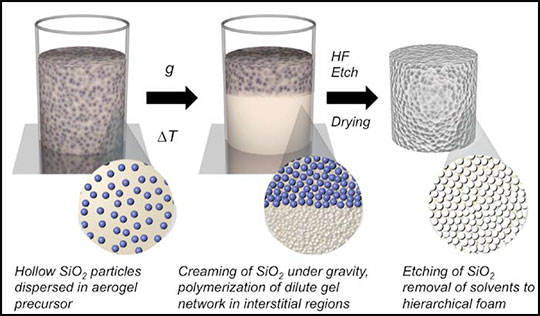
Figure 6. Scheme to form particle-templated porous materials. SiO2 is silica, and HF is hydrogen fluoride.
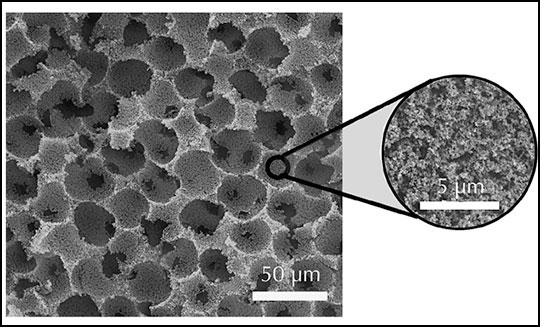
Figure 7. Scanning electron microscopy (SEM) image of a hierarchical DVB foam.
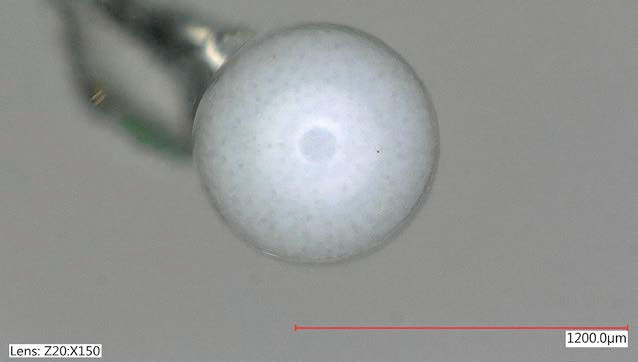
Photo. Optical image of a Marble OMEGA capsule, containing DVB aerogel with 50 μm pores, inside a hydrocarbon polymer ablator shell. Capsule diameter is 800 μm; scale bar is 1200 μm.
The team custom-synthesized deuterium labeled monomers to create polymer foams having bulk density of 30 mg/mL with large pores of 10, 30, 50, and 100 μm. Optical and electron microscopy revealed a nearly homogeneous dispersion of large pores. The aerogel matrix had submicrometer porosity. There was no apparent change to pore morphology at the interfaces of the large porogentemplated voids (right inset).
The team developed new machining techniques using single crystal diamond turning for the foams. The researchers inserted the machined spheres into target capsules for fielding on the laser facilities at the University of Rochester’s OMEGA Laboratory for Laser Energetics and Lawrence Livermore National Laboratory’s National Ignition Facility (NIF).
Reference: “Development of Hierarchical, Tunable Pore Size Polymer Foams for ICF Targets,” Fusion Science and Technology 70, 226 (2016); doi: 10.13182/FST15-227. Authors: Christopher E. Hamilton, Matthew N. Lee, and Nicholas G. Parra-Vasquez (Engineered Materials, MST-7). Additional researchers: Blaine Randolph and Tana Cardenas (MST-7), and John Oertel (Plasma Physics, P-24).
The NNSA Science Campaigns 1, 4, and ICF funded the work, which supports the Lab’s Nuclear Deterrence and Energy Security mission area and the Nuclear and Particle Futures and Materials for the Future science pillars. Technical contact: Chris Hamilton
Physics
HAWC searches for gamma rays from dark matter
Researchers with the High Altitude Water Cherenkov (HAWC) Gamma-Ray Observatory, a joint project of Los Alamos National Laboratory and universities in the United States, Mexico, Poland, and Germany, have released results of the first year of data collection with the full observatory. Located 13,500 feet above sea level on Volcan Sierra Negra in Puebla, Mexico, the HAWC observatory is sensitive to the highest-energy gamma rays ever observed. These photons point back to their astrophysical sources, allowing the scientists to determine whether a given source produces such high-energy gamma rays. Gamma rays probe high-energy particle physics interactions in astrophysical objects.

Figure 8. The HAWC one-year sky map with several dark matter target regions overlaid as white circles (for extended objects) and magenta points (for point-like objects). There are over 20 known regions of high dark matter density within HAWC's field of view.
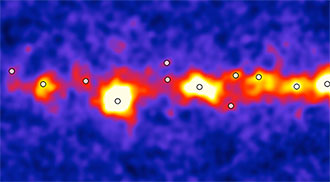
Figure 9. Zoomed-in view of the Galactic Plane showing sources of TeV gamma rays observed in the HAWC survey.
The map included measurements from flickering black holes, pulsars, supernova remnants, and other objects in extreme environments. In the first year of data, HAWC picked up 40 distinct sources of gamma rays, 10 of which had not been observed previously. The map is revealing new information about astrophysical particle accelerators.
HAWC is based on the water Cherenkov detection technique that Los Alamos researchers and collaborators pioneered at the Milagro observatory. Because HAWC observes 24 hours per day and year-round with a wide field-of-view, it can uniquely monitor for gamma ray flares from sources in our galaxy and other active galaxies. The combination of the large HAWC detection area and high altitude give the observatory an unprecedented look at the highest energies for sources throughout the sky.
One of the HAWC science goals, led by the team at the Laboratory, is to search for gamma rays coming from regions of dark matter in space. The nature of dark matter means that it does not typically emit photons. Scientists theorize that two dark matter particles could annihilate one another to produce a signal of gamma rays. Gamma rays could also be produced if the dark matter particles are unstable and decay. The HAWC detector is looking for gamma rays from these processes to verify if dark matter produces gamma rays.
The HAWC detector sees over 2/3 of the sky. Therefore, it has the ability to observe many different dark matter targets, such as dwarf satellite galaxies, across the sky. HAWC, probing these regions with unprecedented sensitivity at the highest energies, did not see any excess of photons. This non-detection constrains some theoretical models, which predicted HAWC would observe a clear excess of photons in these regions. HAWC continues taking data. Its sensitivity will improve over the next few years, allowing it to test more theories of dark matter.
LANL researchers are pushing the HAWC observatory to better sensitivity and a higher energy reach. A Laboratory Directed Research and Development (LDRD) Program is funding the LANL team to expand the area of the HAWC array by four times, which will allow an even higher energy reach and significantly improve the sensitivity of the HAWC observatory. This enhancement will enable an even stronger search for gamma-ray emissions from dark matter and high-energy astrophysical sources within the HAWC field-of-view.
The National Science Foundation and the DOE Office of Science, Office of High Energy Physics, provided funding for the United States’ participation in the HAWC project. The Consejo Nacional de Ciencia y Tecnología is the primary funder for Mexican participation. More information on HAWC.
Brenda Dingus (Neutron Science and Technology, P-23) is the principal investigator for the DOE Office of Science funding for HAWC. Los Alamos researchers include: Pat Harding, Patrick Younk, Andrea Albert, Hao Zhou, and Tilan Ukwatta (P-23); Gerd Kunde (Subatomic Physics, P-25); and Gus Sinnis (Experimental Physical Sciences, ADEPS). T
he work supports the Laboratory’s Global Security mission area and the Nuclear and Particle Futures and Science of Signatures science pillars by increasing our understanding of high energy and plasma physics and astrophysics and by developing expertise and capabilities in particle detection, data acquisition systems, and big data analysis. Technical contact: Pat Harding
Theoretical
First evidence for quantum degenerate plasmas at the National Ignition Facility (NIF)
As the density of a plasma increases, or its temperature decreases, it eventually transitions to a quantum degenerate plasma, wherein the quantum nature of its constituent particles starts to affect its macroscopic properties. The pressure of the system becomes almost independent of its temperature, in strong contrast to an ideal gas whose pressure is proportional to the temperature. Quantum plasmas have received much attention in fields ranging from astrophysics to condensed matter physics. However, studies of the effects of quantum degeneracy in inertial confinement fusion systems (ICF) have only become possible very recently, through studies of the cold dense fuel surrounding the hot spot of cryogenic capsules at the National Ignition Facility (NIF). The theoretical and experimental NIF Radiochemistry Team developed diagnostics to probe the properties of this cold dense fuel. These diagnostics enabled the researchers to determine the effects of quantum degeneracy on plasma stopping powers.

Figure 12. An imploded NIF cryogenic capsule, as imaged by LANL’s neutron imaging facility. As neutrons (n) from the burning hotspot (red region) traverse the surrounding quantum degenerate cold dense fuel (cyan region), they knock some of the deuterium (D) and tritium (T) ions up to MeV energies. These knock-on (KO) ions can then interact with thermal ions in the cold fuel. The resulting DT reaction produces a reaction-in-flight neutron. Image courtesy of Frank Merrill, P-23.
The team made the first measurement of the shape of the highest energy particles produced in NIF capsules, namely reaction-in flight (RIF) neutrons, with energies up to 30 MeV. Theoretical (T) Division’s calculations motivated the research. The calculations indicated that the spectra for RIF neutrons in degenerate plasmas would be distinctly different from those in nondegenerate burning plasmas. Chemistry (C) Division collaborated with the Radiochemistry Team at Lawrence Livermore National Laboratory (LLNL) to measure the shape of the RIF spectrum by comparing neutron activation in thulium (Tm) and bismuth (Bi) foils placed 50 cm from the capsule target.
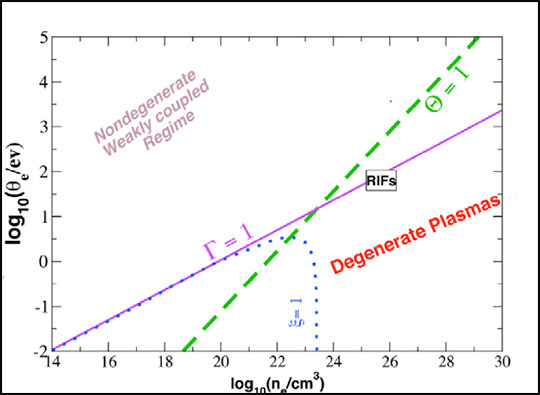
Figure 13. Specialized high-efficiency detectors enabled measurements of reaction-in-flight (RIF) neutrons, which provide the first probe of plasmas under quantum degenerate conditions. Degenerate plasmas are those with electron densities and temperature below the line labeled Θ=1 in Figure 13. The line labeled Γ=1 (ξ=1) separates weakly coupled from strongly coupled plasmas for non-degenerate (degenerate) plasmas. The RIF spectrum was unusually hard in energy, with twice as many RIFs observed above 22.5 MeV compared to what would be expected for a non-degenerate burning plasma.
The team developed new diagnostics to probe properties of the cold dense fuel in NIF capsules. Assay of the foils required two very specialized high efficiency clover detectors, one at LANL and one at LLNL, as well as a high efficiency single-crystal high purity germanium gamma-ray detector. Researchers made measurements of the ratio of the Bi(n,4n) reactions, requiring neutron energy above 22.5 MeV, to the Tm(n,3n) reactions, requiring neutron energy greater than 15 MeV. Detailed theoretical analysis shows that this measured Bi/Tm ratio is twice as large as the expected ratio for burning nondegenerate plasmas. This result indicates that the RIFs are produced in the cold fuel surrounding the hotspot.
The RIF signals provide strong evidence that the cold fuel surrounding the burning hotspot of a NIF layered DT capsule is a quantum electron degenerate plasma. The NIF layered capsules provide a unique laboratory to study the effects of degeneracy on plasma stopping power through the associated enhancement of the highest energy component of the RIF spectrum. These extreme plasma conditions have never been explored previously in burning ICF systems. The measurements also help to constrain the adiabat (the path in density and temperature space) for the capsule compression, which is an important parameter for designers trying to achieve ignition. The team plans to combine RIF measurements with other charged particle diagnostics to study the interplay between hydrodynamical mixing and stopping powers.
LANL team: Anna Hayes-Sterbenz (theoretical lead) and Gerard Jungman (Nuclear and Particle Physics, Astrophysics and Cosmology, T-2), Todd Bredeweg, Malcolm Fowler, Matthew Gooden, and Bob Rundberg (Nuclear and Radiochemistry, C-NR). LLNL team: Charles Cerjan, Gary Grim, Dieter Schneider, Charles Yeamens, and Gene Henry (experimental lead).
NNSA funded the research as part of Science Campaigns C1, C4, and C10. The work supports the Lab’s Nuclear Deterrence mission area and the Nuclear and Particle Futures and Science of Signatures science pillars. Technical contact: Anna Hayes-Sterbenz





